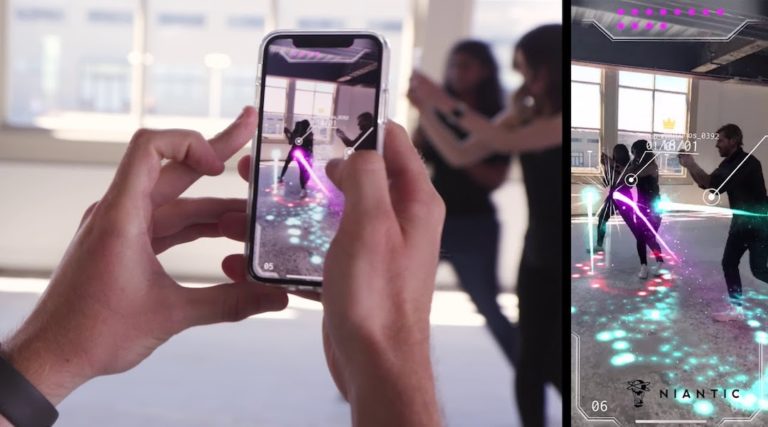
One of our favorite AR topics is how innovation will migrate from adjacent sectors. For example, computer vision requirements of autonomous vehicles will benefit AR as a byproduct. 5G and edge networks are also on this list.
One one level, AR’s heavy compute and graphic needs will benefit from bigger pipes. 5G and edge computing will create a more efficient deployment of compute muscle and bandwidth to enable AR devices. This will phase in, to the tune of a billion projected 5G connections by 2023.
But what is edge computing? 5G is clear in terms of 1000x bandwidth over 4G and other benefits, but edge is less familiar. It essentially brings compute and connectivity closer to devices using a mesh network of stations placed strategically in traffic-optimized clusters.
“It’s not that edge is going to replace the cloud, it’s just going to move the cloud closer to the user,” said Deutsche Telekom director of immersive technologies Terry Schussler at AWE Europe. “We control data transfer at the speed of light, so if we shorten the distance from the data center to the user, we can reduce milliseconds of latency that occur on the Internet.”

Pervasive AR
Sort of like a mesh router network but different, edge computing will be able to have several base stations that work intelligently in unison to provide the most efficient compute and connectivity transfers to nearby devices. The ultimate goal is for this to work even for moving vehicles.
“As we build 5G out, these stations can have compute data centers at their base,” said Schussler. “The distribution of that compute is going to be intelligently performed by software that allows the orchestration of where the compute should come from and be automatic.”
Where this plays out for AR is to power the dream of what Schussler calls “pervasive AR.” Currently AR glasses are mostly used for a single purpose, often in enterprise, with a single app loaded onto a device. Pervasive AR will give us much more functionality and optionality.
“We want to move to a more pervasive time-duration extended experience,” he said. “We will see a transition into next year where we’ll have experiences that last for one to two hours such as a sports or entertainment experience at a stadium, or watching television shows at home.”

Enabling the Magicverse
5G and edge computing will enable this vision of more meaningful and lasting AR, because pervasive computing needs more intelligence to personalize experiences for users. And that requires a level of compute that should happen off-device for optimal data delivery.
“We’re going to have to change from an app focused ecosystem to a people-focused ecosystem,” said Schussler. “That ecosystem is going to be forced to collaborate together to intelligently present information at the right time and the right place and in the right part of your field of view.”
Magic Leap is big on this vision, and it knows 5G is a key piece of the puzzle. At Leapcon, CEO Rony Abovitz unpacked his construct of the magicverse — a series of data layers that can be activated by AR devices on demand, and in the personalized ways Schussler referenced.
“[It’s] almost a digital soul for a physical place. You could think that’s a room, that’s a building, that’s a coffee house, that’s an entire city,” said Abovitz. “When you put incredibly high-speed networks like 5G in those cities, it becomes a platform to develop the most amazing things.”

Enterprise Grade
Niantic similarly sees 5G unlocking long-term vision for mobile AR. Mobile is the key word, given the mobility of Pokemon Go, and of the company’s mission statement to get people outside. This makes high-performance connectivity to far-flung devices a key enabler in its road map.
“5G for us enables a new level of gameplay,” said Niantic CTO Phil Keslin in a recently released video (embedded below), adding that shared experience and movement will benefit from 5G: “In order to create that experience, you need incredibly high bandwidth and incredibly low latency.”
5G-enabled AR use cases could have even more impact in the enterprise given large-scale compute and connectivity. ARvizio explained to us that its software efficiency delivers targeted pieces of 3D models, given bandwidth limitations. But 5G could optimize things further.
“We can do this very nicely today over wifi,” said CEO Jonathan Reeves. “But if you try to run this over LTE, you don’t get our few-seconds response time, it can take 5-10 seconds. And if you have multiple Hololenses syncronized where all viewers are getting updated in real time, it might take 20 seconds and that’s not acceptable. But over 5G, it’s a few seconds,”

Next Steps
Moving forward, Schussler envisions mobile devices, or any radio chip-embedded device, acting as a sort of personal area network for edge computing. That includes smartphones but also smaller connected devices or wearables that can distribute the load optimally (Apple’s plan).
“Maybe your watch acts as an LTE bridge,” he said. “These devices work together using techniques like mesh computing where they share compute capabilities of all the devices in an ecosystem, and we extend that to edge and to backhaul for more powerful experiences.”
As for when, it’s gated by 5G rollouts. But the bottleneck isn’t just the network but 5G phones. We’ll see several in late 2019, followed by the iPhone’s 5G entrance, rumored for 2020. Then 5G won’t just advance AR but vice-versa: AR could accelerate 5G by creating a big point of reliance.
“Every new technology needs an application to really highlight the capabilities of that technology,” said Niantic CTO Phil Keslin (see below). “Augmented reality is truly the killer app for 5G.”
For deeper XR data and intelligence, join ARtillry PRO and subscribe to the free ARtillry Weekly newsletter.
Disclosure: ARtillry has no financial stake in the companies mentioned in this post, nor received payment for its production. Disclosure and ethics policy can be seen here.
Header image credit: Niantic
